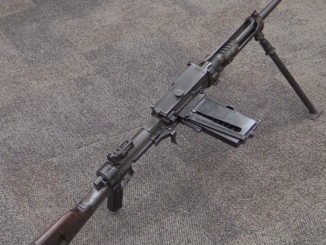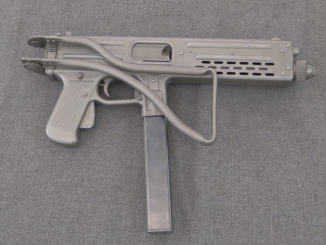In the mid 1980s, an Italian designer named Alphonso Giambelli developed a bullpup pistol-caliber carbine with hopes of selling it to Italian law enforcement. That never happened, but the gun was offered on the commercial civil market as the semiauto AGM-1 by a company named Algimech (after ALphonso GIambelli). At least a handful of these carbines came into the US before the 1989 assault weapons import ban, chambered for 9mm Parabellum and 9x21mm. they were also offered in a variety of other calibers (.45 ACP, .45 HP, .22LR, .22 WMR) but it is unclear if any of those were ever manufactured.
The AGM-1 has an 18″ barrel and uses slightly modified Browning High Power magazines for both 9×19 and 9x21mm. The barrel is easily removed, and there is nothing particularly complex about its design.




Seems pointless. Mill a complex telescoped bolt, only to add a buttstock. Lose the ergonomics of loading through the grip, add an 18″ barrel to make it less compact than an Uzi or even a shorty AR. A bullpup 9mm could be a marvel of compactness, but this isn’t it!
I agree 🙂
There doesn’t seem to be a clear merit to this creation.
In Italy this had been classified as a rifle.
For Italian law, the weapon must have a barrel longer than 30cm and to be longer than 60cm overall to be classified as a rifle. Hence the dimensions.
A. It is larger in both those dimensions.
B. Ian said it was designed for LE.
It’s possible this is an export variant intended to meet US laws, and it would be cool to see a more compact version if it exists. OTOH, so much of the structure seems like was designed at this length (it doesn’t look stretched like a civilian Uzi or HK).
A. 67cm total lenght. It would have been really too limiting to make it exactly 601mm long, and so not have the possibility to adopt a slightly shorter barrel, or a slightly shorter buttpad if needed.
B. Whatever Ian said, the weapon is classified in category C7 (semiauto rifle) in the “Catalogo Nazionale Armi”
https://webinfo.bignami.it/bignami/catnaz_lis.jsp?nback=494&offset=4472
https://webinfo.bignami.it/bignami/catnaz_lis.jsp?nback=499&offset=4597
I understand and agree with the spirit of your first point, but the specs of the AGM go well beyond that.
US manufacturers often make 16.25″ rifle or 18.5″ shotgun barrels, and 26.5″ OAL bullpups. It would of course have made sense for the Italians to pad their required dimensions by the metric equivalents (5-15mm) rather than just 1, but an extra 70-76mm would only make sense for the US.
scusate dove posso trovare un video o il disegno dei ricambi per poterla rimontare?
The replaceable magazine well, and possibility of increased mass on the bolt lead me to wonder if this design would be workable in .30 Carbine – with an 18″ barrel that would seem a reasonably useful arrangement.
Also: is that a bayonet lug at the bottom of the front sight block?
There’s a lot of space along the top of that bolt for adding or removing weights.
It’s not as elegant as the weight for a Gevarm open bolt .22
Where you can simply turn the weight around and it stays in the rifle and acts as a spring guide, when you want to use light recoiling loads.
A few lead or tungsten weights, and a stack of belville washers at the back of the receiver, the algimech might well work with. 30 Carbine
Are you aware of a weapon in .30 U.S.carb. which would operate with plain blowback? I am not saying it can’t, just asking; I am not aware of one.
“(…)weapon in .30 U.S.carb. which would operate with plain blowback(…)”Thompson Light Rifle https://guns.fandom.com/wiki/Thompson_Light_Rifle
I am not sure if it is plain by your standard but it was certainly blowback
That’s good find Daweo. Well if it is not retarded like the Dominican/ Kiralyi carbine, than it must be plain blowback. It surely looks robust and purposeful. With machined receiver it could cope well.
It seems working as open bolt firing… Needing lesser mass than cloced bolt…
In fact, any firearm using small firearm cartridges, can be made in closed bolt firing plain blowback… If the owner being ready to carry such a weight of the gun… With a 40 centimeters of barrel lenght, it needs approximately 2,5 Kg of bolt weight for .30” carbine round… One can figured out such a bolt body as using a roughly 16 centimeters of steel rod of 5 centimeters of diameter or, roughly 5 centimeters of tungsten carbour mass with the same thickness… This is for a free unsupported 2 milimeters of case blowback for ensured firing… In case of deciding of 3 milimeters, which is still remaining in safety zone, these values decrease of one third’s… IMHO…
@ Strongarm
“limited tests performed with a Winchester Model 1907 rifle (using blowback locking) and a Thompson Ml submachine gun, both converted to fire the .30 Ml cartridge, demonstrated that a 570 gram bolt was adequate even for proof
rounds.”
“Submachine Gun Designer’s Handbook”
by George Dmitrieff © 1981
“(…)owner being ready to carry such a weight(…)”
In such circumstances, I can only suggest
GUN, SUBMACHINE – U.S. SUBMACHINE GUN T29 .30 SN# X39
http://ww2.rediscov.com/spring/VFPCGI.exe?IDCFile=/spring/DETAILS.IDC,SPECIFIC=10211,DATABASE=48079129,
Manufactured by Hyde & Sampson, Dayton, Ohio – Experimental version of the M3A1 chambered for the .30 cal. carbine round and equipped with a longer 14″ barrel. Skeleton magazine appears to have been made from two M1 magazines. This specimen was functioned fired 1500 rounds.(…)Study of the T29 Submachine Gun showed that the type of spring loaded ejector, the type of feed ramp necessary, and the design of spring would require further development. However, in that the Carbine, Caliber .30, M2, selective semi-and full-automatic fire was standardized it was not deemed advisable to continue further development work on the T29 model.
If you want to know more be informed that A physical sample of this item and drawings pertaining thereto were retained at Springfield Armory for possible future reference.
“(…)weapon in .30 U.S.carb. which would operate with plain blowback(…)”
Do not forget that .30 Carbine cartridge is child of .32 WSL whose host weapon, namely Winchester 1905 was blow-back operated. Woodhull carbine was submitted for trials https://www.forgottenweapons.com/light-rifle-program/woodhull-carbine/
it seems to be working after improving. It is hard to say if tester fears would proved true or it was only bias from first trial.
Continuing weapons related to U.S. Light Rifle trials, there was blowback operated gun developed by Val A. Browning for Colt’s Patent Firearms & Manufacturing Hartford, CT but it was withdrawn prior to trials by manufacturer, prototype(s) could not be completed in time though it managed to get few related patents namely US2401903, US2385057, US2341204
http://www.uscarbinecal30.com/development.html
There was also the Hyde Carbine, submitted in 1944, by one of the same guys of one of the prototypes tested in 1941 (the Bendix-Hyde Light Rifle).
https://www.forgottenweapons.com/submachine-guns/hyde-carbine-1944/
It seems that, at least as a prototype, a .30 Carbine version existed.
https://www.softairdynamics.it/wp-content/uploads/2016/03/SAI-30-024.jpg
Notice the different riveting and ejection port in respect to the 9mm and .22LR versions.
I actually got to handle this gun at the first 1984 Millipol in Paris. i didnt get too shoot it(but got some range time on a jatimatic) but it felt very good/handy.I do remember the chap selling it was very friendly which was unusual unless you were military or police
By the way Keith the chaps at Gevarm once told me in a letter that they made and sold a select fire version of their .22 as a training weapon for a foreign ie not french government hint/nudge
“(…).45 HP(…)”
Specimen can be seen here https://naboje.org/node/5370
Aliases .45 ACP Short, .45 Hinterberg
has shorter cases than .45 Auto, thus is different cartridge, thus does not as military cartridge
“In the mid 1980s, an Italian designer named Alphonso Giambelli developed a bullpup pistol-caliber carbine with hopes of selling it to Italian law enforcement.(…)”
Was there any inspiration between this weapon and Steyr AUG para 9 mm in either way
https://modernfirearms.net/en/submachine-guns/austria-submachine-guns/steyr-aug-para-eng/
?
Ideas are routinely “borrowed” and “improved on” with not much success in real applications. There are more hunters than rabbits in the field.
I remember reading notes by vz.23/25 SMGs who mentioned that many ideas are “claimed out” already. And that was shortly after WWII.
Arguments about utility ( or lack thereof ) and design concept aside, the AGM-1 appears to be a well-made weapon with good fit and finish. I wonder if Ian will be able to make a trip to the range with it to see how well it handles and works.
Good to see your comments again Earl . I have missed your balanced and knowledgeable input .
There cannot be doubt about fit and finish, I think the general reservation is about concept of bullpup 9mm carbine. You do not get much of velocity gain after say 10in of barrel. Look around if you find anything more than that (I mean outside of legal requirement).
Ballistics by the Inch http://www.ballisticsbytheinch.com/9luger.html
“(…)Look around if you find anything more than that (I mean outside of legal requirement).”
For 9×19 Parabellum weapon with barrel no shorter than that and not due to legal reasons see MK.36,III https://modernfirearms.net/en/submachine-guns/germany-submachine-guns/mk-36-schmeisser-eng/ with 502 mm barrel
“(…)do not get much of velocity gain after say 10in of barrel.(…)”
This would need further investigation, through more than 100 years there were many different loadings for said cartridge. There were so many, so it is hard to definitely say either war. Sometime one nation used loading of 9×19 which should be used in one weapon type and must not be used in another, for example Sweden
http://www.gotavapen.se/gota/m07/pist07_4.htm
…Swedish m/40 started to be produced in large numbers. This was not the case, because when Sweden accepted the heavy armour piercing submachine gun cartridge 9 mm called m/39b (with red seal), the m/40 could not stand the heavy submachine gun ammo.
I remember being told about 1990 by the steyr aug rep. here in France that the 9mm version didnt exist when american gun mags had published photos. One of the examples of being ignored if you are not military or police
Was it offered in .30 Luger (7.65mm Parabellum)? Browning was selling their Hi-Power in that caliber in Italy because it was not recognized as a civilian-prohibited military round.
Now imagine this same gun with the barrel cut back by 8 inches, and a suppressor of that same length attached, firing subsonic .45 Auto as a short-range sniper carbine.
Interesting story.
And a good example of “how not to do it”.
In mechanical terms, it is quite possible to give a rating of “satisfactory” or even “not bad”.
Even if, for a while, forget my dislike for bullpups, they made a pistol with a stock. With dimensions and weight like an assault rifle.
With a price tag like an assault rifle.
Requiring a licensed hemorrhoid like an assault rifle. (despite the pointlessly long barrel, it’s still SBR)
Can anyone explain why “this” is better, say, than a Glock with a converter carbine?
Therefore, in a practical sense, this is just some kind of schizoid delirium. Like aqualag with a built-in parachute.
Dogwalker,
Thompson M1 is open bolt firing plus having static friction delay… Winchester 1907 had also firing issues…
570 grams of bolt weight gives approximately 9 milimeters of unsupported blowback for the empty case of .30” carbine round and in practice if it is made of brass, still remaining unruptured form with some swells… However, I had seen and even fired pistols carrying only 150 grams of bolt using 9mm Parabellum round recoiling back roughly 8 milimeters of unsupported backward travel remaining in still reloadable form…. This means, Newton in practice is somewhat different.
According to Bill Holmes a 9mm blowback bolt should weigh at least 10 ounces. A 45 bolt a minimum of 12 ounces.
Ten ounces translates to 0.283 kg. That is perhaps possible, but not likely for plain blowback 9mm Para. Typical breech locked pistol slide would be about that. The bolt for blowback SMG I have seen and was able to scale was around 0.35 kg which is already marginal; something close to 0.5kg is more realistic. Besides, the greater weight yields more favorable cycle time therefore better reliability.
Those are simply the mass required to avoid overpressure issues.
The weight of commercial blowback SMGs’ bolts is related to the intended ROF. That of blowback pistols is related to the perceived recoil and long term survival of the slide and frame.
Yeah. Much full size pistols have a slide heavy enough to work as pure blowbacks. But, without the slowing-down provided by the short recoil of the barrel (both for the added weight of the barrel and the friction with the projectile attempting to drag the barrel forward with him) the battering of the slide on the frame would shorthen the life of the weapon quite a lot.
My M-11/9 bolt is 13oz / 369g.
IE in 2019 Ian reviewed the Bernardelli UB, blowback 9mm Parabellum pistols, that had not been a success, but had been commercially sold for some time. He didn’t tell the weight of the slide, but their dimensions, and so their mass, seem to be perfectly normal for full size 9mm. The survival of the weapon was assured buy the buffer spring.
Also the Beretta M1938 blowback 9mm Parabellum prototype had nothing out of the ordinary concenring the mass of the slide. It’s problem was the propensity to break the hammer, so, even if there were no overpressure issues, the speed of the slide was excessive for the mechanic.
http://www.exordinanza.net/foto/Beretta51/Beretta51_38.jpg
Good point about the hammers (also a noted issue in 9mm ARs). It’s obviously not an issue in the M-11/9. I haven’t weighed my AP-9 (striker-fired) bolt, but it seems quite compact; in fact, one of my first reactions on seeing the AGM telescoped bolt was that they could easily have used an AP-9 like bolt (very simple milling from roundbar in a simple tube receiver) and a slightly shorter buttstock.
Hammers seem to be a mixed bag for blowbacks. On one hand, the need to overcome their inertia and spring has been noted in some blowback 9mms as helping delay opening / slowing bolt velocity / enabling a lighter slide or bolt. On the other hand, they are vulnerable to damage (along with their pivot pins, associated area of the lower, etc.) if too light a slide or bolt is used. Someone with a blowback that used the hammer as a quasi-delaying mechanism would probably need to treat it as a wear component and replace it after X number of rounds.
Completely off-topic (I wish this board had an Edit function), the bolt mass you posted for the .30C Thompson works out very close to 1.5x the M-11/9’s.
“Thompson M1 is open bolt firing plus having static friction delay…”(С)
The Thompson M1 did not have a “static friction delay”.
Just a direct blowback.
The absolute value of parameters such as the mass of the bolt has no direct meaning.
Whether the brass breaks or not is determined by a combination of factors that determine the magnitude of the displacement of the brass during the lifetime of the pressure, which is sufficient for the brass to “stick” to the walls of the chamber.
However (by the way) no Thompson had any “static friction retention.”
This is a delayed recoil system.
Is it called so… Oh my old mind…
I had no idea Kel-Tec had in Italian subsidiary
The name of the company was “Al. Gi. Mec.”. No version of the gun in .30 Luger was ever made.